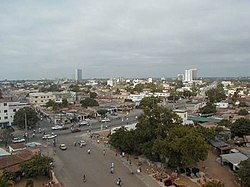Lomé
Lomé is the capital city of Togo. Lomé is the administrative and industrial center of the country. The city is also the main port of Togo. The city exports coffee, cocoa, copra, and palm kernels. The population of the city was estimated as around 700,000 people in 1998. It is estimated that more than 1 million people live in Lomé area at that time.[2]
City | |
 | |
| Coordinates: 6°7′55″N 1°13′22″E / 6.13194°N 1.22278°ECoordinates: 6°7′55″N 1°13′22″E / 6.13194°N 1.22278°E | |
| Country | |
| Region | Maritime Region |
| Prefecture | Golfe |
| Government | |
| • Mayor | Aouissi Lodé |
| Area | |
| • City | 99.14 km2 (38.28 sq mi) |
| • Metro | 280 km2 (110 sq mi) |
| Elevation | 10 m (30 ft) |
| Population (2010 census) | |
| • City | 837,437 |
| • Density | 9,305/km2 (24,100/sq mi) |
| • Metro | 1,477,660 |
| • Metro density | 5,608/km2 (14,520/sq mi) |
| Time zone | UTC |
| HDI (2017) | 0.593[1] medium · 1st |
Lomé is on the Gulf of Guinea. It is in the south west of Togo, on the border between Togo and Ghana. Things to see in the city include Lomé Grand Market, the Togo National Museum in the Palais de Congrés, a fetish (voodoo) market, Lomé Cathedral, beaches and the former wharf.
History
The city was founded in the eighteenth century by the Ewe people. In 1882, the village, known then as Bey Beach, became a major trading center for the British.
Bey Beach became the capital of Togo when the German rulers moved the capital from Aneho in 1897. The city then grew quickly until it was taken by the French Army in 1914 during World War I.
Lomé Media
Loading of cotton bales (1885)
Alley leading to the Governor's Palace (1904).
Entrance of University of Lomé
References
- ↑ "Sub-national HDI - Area Database - Global Data Lab". hdi.globaldatalab.org. Retrieved 2018-09-13.
- ↑ "Information on Lome". World Book Encyclopedia. Archived from the original on 2006-11-10. Retrieved 2007-03-06.
| Wikimedia Commons has media related to Lua error in Module:Commons_link at line 62: attempt to index field 'wikibase' (a nil value).. |










